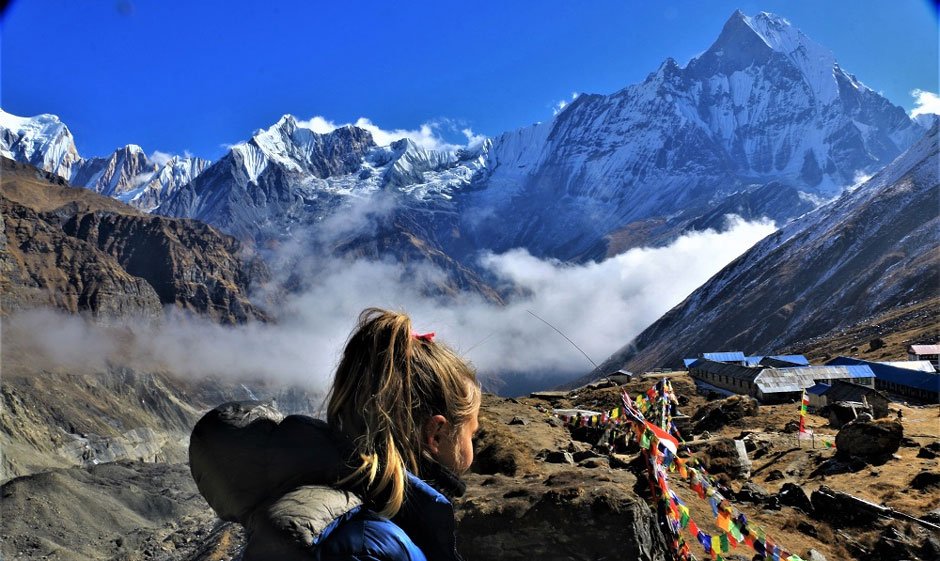Skip to the good bit
ToggleIntroduction
The Annapurna Base Camp (ABC) trek stands as one of Nepal’s most iconic and accessible high-altitude adventures. Nestled within the Annapurna Sanctuary, this trek offers a harmonious blend of awe-inspiring Himalayan vistas, rich cultural encounters, and a journey through diverse ecological zones. Opting for a guided trek not only enhances safety and logistical ease but also provides deeper insights into the region’s unique heritage and natural beauty.
1.Understanding the Annapurna Base Camp Trek
The ABC trek typically spans 7 to 12 days, commencing from Nayapul, a short drive from Pokhara. Traversing through verdant rhododendron forests, terraced farmlands, and traditional Gurung and Magar villages, trekkers ascend to the base camp situated at an elevation of 4,130 meters. The journey culminates with panoramic views of majestic peaks like Annapurna I, Machhapuchhre (Fishtail), and Hiunchuli. The trail’s moderate difficulty level makes it suitable for both novice and seasoned trekkers, offering a fulfilling Himalayan experience without the extreme challenges of higher-altitude treks.
2.Advantages of Opting for a Guided Trek
Embarking on the ABC trek with a certified guide offers numerous benefits. Guides possess extensive knowledge of the terrain, weather patterns, and cultural nuances, ensuring a safer and more enriching experience. They assist in acclimatization strategies, navigate logistical challenges, and provide valuable insights into local traditions and customs. Moreover, guides facilitate interactions with local communities, enhancing cultural immersion. In unforeseen circumstances, such as sudden weather changes or health issues, a guide’s expertise becomes invaluable, ensuring prompt and appropriate responses.
3.Essential Permits and Documentation
Trekking to Annapurna Base Camp requires two primary permits: the Annapurna Conservation Area Permit (ACAP) and the Trekkers’ Information Management System (TIMS) card. These permits are obtainable in Kathmandu or Pokhara and are essential for conservation efforts and trekker safety. Guided treks often include the acquisition of these permits in their packages, streamlining the process for trekkers.
4.Optimal Seasons for Trekking
The ideal periods for the ABC trek are during the pre-monsoon (March to May) and post-monsoon (September to November) seasons. These months offer stable weather conditions, clear skies, and moderate temperatures, enhancing the trekking experience. Spring brings blooming rhododendrons, adding vibrant colors to the trail, while autumn offers crisp air and unobstructed mountain views. While winter treks are possible, trekkers should be prepared for colder temperatures and potential snowfall, which may affect trail accessibility.
5.Accommodation and Culinary Experiences
Along the trekking route, a network of teahouses provides basic yet comfortable accommodations. These establishments offer twin-sharing rooms, communal dining areas, and essential amenities like hot showers and charging facilities, often at an additional cost. Meals typically consist of traditional Nepali dishes, with “dal bhat” being a staple, alongside a variety of international options. Guides often have established relationships with teahouse owners, ensuring timely reservations and quality services, especially during peak seasons.
6.Health Considerations and Acclimatization
While the ABC trek is considered moderate, altitude-related challenges can arise. It’s crucial to ascend gradually, allowing the body to acclimate and reduce the risk of Acute Mountain Sickness (AMS). Symptoms like headaches, nausea, and dizziness should not be ignored. Guides are trained to recognize these signs and can make informed decisions about rest days or descent if necessary. Maintaining hydration, consuming balanced meals, and avoiding alcohol can further aid in acclimatization.
7.Cultural Immersion and Local Interactions
The trek offers a unique opportunity to engage with the Gurung and Magar communities, known for their rich traditions and hospitality. Villages like Ghandruk and Chhomrong provide insights into traditional lifestyles, architecture, and customs. Participating in local festivals, observing daily routines, and visiting monasteries enrich the trekking experience. Guides often facilitate these interactions, translating and explaining cultural practices, thereby deepening understanding and appreciation.
8.Environmental Responsibility and Sustainable Practices
The increasing popularity of the ABC trek underscores the importance of sustainable trekking practices. Trekkers are encouraged to minimize their environmental footprint by carrying reusable water bottles, avoiding single-use plastics, and disposing of waste responsibly. Engaging with eco-conscious trekking agencies and staying in teahouses that implement sustainable practices further supports conservation efforts. Guides play a pivotal role in educating trekkers about the local ecosystem and promoting environmentally friendly behaviors.
9.Financial Planning and Trekking Costs
The cost of a guided ABC trek varies based on factors like duration, services included, and group size. On average, trekkers can expect to spend between $900 to $1,500. This estimate typically covers permits, guide and porter fees, accommodations, meals, and transportation. Additional expenses may include personal gear, tips, and unforeseen costs. Engaging with reputable trekking agencies ensures transparency in pricing and value for money.
10.Preparing for the Trek: Physical and Logistical Readiness
While the ABC trek is accessible to individuals with moderate fitness levels, preparation enhances the experience. Engaging in cardiovascular exercises, strength training, and regular hiking can build endurance and reduce fatigue during the trek. Packing essentials include layered clothing suitable for varying temperatures, sturdy trekking boots, a reliable backpack, and necessary personal items. Guides often provide comprehensive packing lists and can advise on gear rentals or purchases in Kathmandu or Pokhara.
Conclusion
Embarking on a guided trek to Annapurna Base Camp offers an unparalleled blend of natural beauty, cultural richness, and personal achievement. The guidance of experienced professionals not only ensures safety and logistical ease but also deepens the connection to the landscapes and communities encountered. With thoughtful preparation and a spirit of adventure, the ABC trek becomes more than a journey—it transforms into a life-enriching experience that resonates long after the descent.







